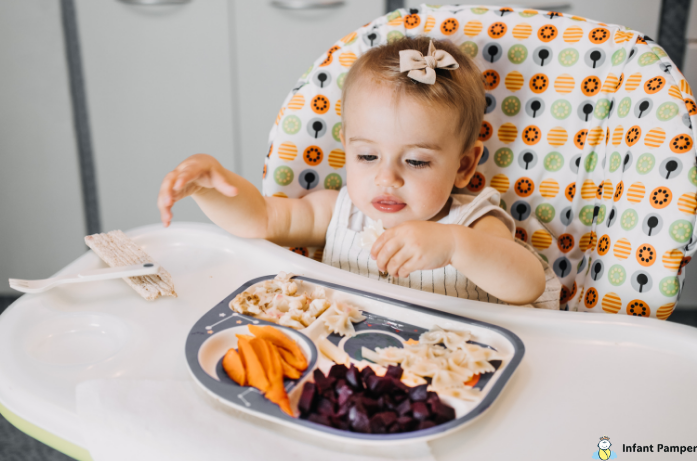By a Caring Mom at Infant Pamper
Introducing healthy finger foods for toddlers is an exciting and sometimes messy milestone. It helps the baby establish his or her own eating habits, develop fine motor skills, and discover the world of different textures and flavors. Nevertheless, parents often find it difficult to decide what is safe, nutritious, and easy to prepare for their toddlers.
This guide from Infant Pamper offers you a list of 10 healthy finger foods for toddler-friendly, easy to make, delicious and strong in nutrition. This list includes everyday fruits, veggies, proteins, and grains that you likely already have in your kitchen. And don’t worry, we have smart tips, preparation ideas, and a few easy recipes included to make mealtimes easier for you.
Why Finger Foods Matter
Finger foods for your toddler are a great and at times messy milestone to reach. They are like small bites for your toddler but they are stepping stones to self-feeding and better eating habits. Finger foods give your child a lot of advantages, such as:
- Better hand-eye coordination
- Higher sensory development
- More control over hunger cues
- More confidence in eating independently
If finger foods are introduced in a safe and thoughtful manner, then the risk of picky eating will be reduced in the years to come.

10 Healthy Finger Food Ideas for Toddlers
Each of these categories contain nutritious toddler meal ideas that are suitable for toddlers and are also fast to prepare.
1. Soft Fruits- Easy Finger Foods for Toddlers
Fruits are a rich source of vitamins and fiber that are very much needed by a child’s body. Serve soft fruits that are ripe and can be easily mashed or gummed.
The best fruits for toddlers are:
- Bananas (sliced or mashed)
- Ripe pears and peaches (peeled and cut into small pieces)
- Avocados (cut into small pieces or put on toast and smashed)
- Blueberries (smashed for safety)
- Strawberries (cut into small pieces)
- Watermelon and cantaloupe (seedless and cut into small pieces)
- Kiwi (peeled and cut into small pieces)
- Applesauce (unsweetened)
Tip: If fruits are hard to hold, lightly coat them in crushed cereal or ground flaxseed to make it easier for them to grip.
2. Steamed Vegetables- Nutritious Toddler Finger Foods
Soft-cooked veggies are perfect for finger feeding and full of vitamins, minerals, and fiber.
Best vegetables for toddlers:
- Sweet potato (roasted or steamed, diced into little pieces)
- Carrots (steamed till very soft, cut into very thin strips)
- Green peas (a little mashed)
- Zucchini and squash (either roasted or sautéed)
- Broccoli and cauliflower florets (florets that are steamed till very soft)
- Asparagus (cooked and chopped into soft pieces)
- Green beans (cut into soft segments that are short)
Tip: Avoid raw vegetables during this stage as they can cause choking hazards.
3. Whole Grains
Different kinds of whole grains should be introduced to toddlers which will not only help the kids with but also provide them with energy for longer periods.
Great grain options:
- Oatmeal (a mixture thick enough which can be molded into small bites)
- Quinoa (cooked, then mixed with mashed veggies or cheese)
- Brown rice (shaped into small clumps or balls)
- Whole grain toast (cut into strips and spread with smashed avocado, hummus, or nut butter)
- Whole wheat pasta (cooked very well and cut into small pieces)
- Soft and healthy muffins like banana or pumpkin are good choices.
Note: For safety reasons, whole nuts and pieces of nut butter must be avoided. Only thinly spread nut butters are allowed.
4. Protein- Packed Foods for Toddlers
Protein is the most important nutrient for your toddler’s growth and development. Give small manageable pieces of soft and cooked proteins.
Best protein-rich toddler foods:
- Scrambled eggs or chopped hard-boiled eggs
- Cooked and shredded chicken or turkey
- Ground beef or meatballs (soft and cut small)
- Fish like salmon or cod (thoroughly boned and flaked)
- Tofu (cubed and baked or pan-fried for texture)
- Beans (mashed or whole if soft, like black beans, lentils, or chickpeas)
- Hummus (as a spread or dip)
Note: High sodium and preservatives make processed deli meats unsafe.
5. Dairy Delights- Calcium-Rich Toddler Snacks
Calcium and vitamin D are the main nutrients that dairy products provide for bone development. Foods that are friendly to toddlers from the dairy category:
Toddler-friendly dairy foods:
- Cheese (cut into cubes, shredded, or melted into other foods)
- Plain yogurt (served as-is or frozen into bites)
- Cottage cheese (served plain or mixed with fruit)
Tip: Choose full-fat dairy options unless otherwise advised by your child’s doctor.
6. Easy Quesadillas & Wraps- Quick Toddler Meals
Whole wheat tortillas make quick toddler snacks that are nutritious and fun.
Ideas:
- Quesadilla with cheese and avocado (cut into small triangles)
- Turkey and sweet potato wrap
- Scrambled eggs with spinach in a mini wrap
Tip: Lightly toast wraps to make them easier to hold but still soft enough to chew.
7. Mini Pancakes & Waffles- Breakfast Finger Foods
Pancakes and waffles can be homemade or low-sugar versions, which are great for babies to self-feed.
Healthy add-ins:
- Mashed banana
- Pumpkin puree
- Oats or whole wheat flour
- Blueberries or grated zucchini
Cut into strips or bite-sized pieces for safe, self-feeding snacks.
8. Homemade Muffins & Bars
Mini muffins made with fruits, veggies, and whole grains are nutritious and portable.
Toddler-friendly recipes:
- Banana oat muffins
- Zucchini carrot muffins
- Apple cinnamon mini muffins
Do not use added sugars and instead, use natural sweeteners such as mashed banana or applesauce.
9. Dips & Spreads
With soft spreads, you can bring in new textures and flavors.
Toddler-safe dips:
- Mashed avocado
- Greek yogurt with cinnamon
- Hummus
- Smooth nut butters (thin layer)
Pair them with soft toast strips, cooked veggies or crackers.
10. Creative Combos- Mix & Match Toddler Meals
Combine foods from different groups to create balanced mini meals:
- Protein + Grain + Veg: Chicken, brown rice, and peas
- Fruit + Dairy: Banana slices with shredded cheese
- Grain + Spread + Fruit: Whole grain toast with peanut butter and thinly sliced strawberries
- Veg + Dip: Steamed carrots with hummus
Safety Tips for Finger Foods
To prevent choking hazards:
- Cut foods into small and manageable pieces
- Always watch over your child while eating
- Do not give hard foods such as whole nuts, raw carrots, and grapes (unless quartered)
- Only give foods when your toddler is seated, calm and upright
To find out more about feeding safety guidelines, please go an American Academy of Pediatrics initiative.
For more professional guidance on healthy and safe snack choices, visit Kids Health and the AAP
Final Thoughts
The introduction of healthy finger foods for toddlers should be enjoyable and no-pressure for the toddlers. Each toddler is different, some will take it immediately, and others will require a little more coaxing. Continue to offer a variety, keep it simple, and above all, have faith in the process.
Make sure to keep this list within your reach while you plan meals and feel free to rotate through the foods based on the season or what you have at home. The aim is to cultivate curious and healthy eaters one bite at a time!
FAQs About Toddler Finger Foods
1. What age can I start giving finger foods to my toddler?
Typically, babies are ready for finger foods between 8 and 10 months when they can sit up by themselves and pick up small things.
2. How do I know if a finger food is safe for my toddler?
The food should be soft, cut into small pieces, and chewing easily. Hard, round, or sticky foods that can cause choking should be avoided at all cost.
3. Can I offer the same finger foods every day?
Try to offer different foods as they will not only give you a balanced diet but also help your toddler get used to various flavors and textures.
4. Should I season toddler finger foods?
Herbs light seasoning or just a tiny pinch of spices is okay, but stay away from extra salt or sugar. Toddlers’ kidneys are still developing and cannot process too much sodium.
5. What if my toddler refuses finger foods?
It is common for toddlers to be selective about their food choices. Continue to present various choices without making it a stressful situation. Patience and persistence are often rewarded.
Disclaimer: If you have doubts regarding allergies or certain foods, please always consult your pediatrician or a registered dietitian especially if your toddler has shown any sensitivities.
Looking for more baby and toddler feeding tips? Stay tuned to Infant Pamper for more expert guidance, real-mom advice, and healthy recipes your little one will love.




